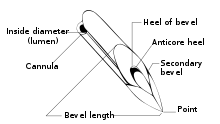Our website is made possible by displaying online advertisements to our visitors.
Please consider supporting us by disabling your ad blocker.
Hypodermic needle
| Hypodermic needle | |
|---|---|
 Different bevels on hypodermic needles | |
| Classification | Medical device |
| Industry | Healthcare |
| Application | Injection |
| Inventor | Francis Rynd |
| Invented | 1844 |


A hypodermic needle (from Greek ὑπο- (hypo- = under), and δέρμα (derma = skin)) is a very thin, hollow tube with one sharp tip. It is one of a category of medical tools which enter the skin, called sharps.[1] It is commonly used with a syringe, a hand-operated device with a plunger, to inject substances into the body (e.g., saline solution, solutions containing various drugs or liquid medicines) or extract fluids from the body (e.g., blood). Large-bore hypodermic intervention is especially useful in catastrophic blood loss or treating shock.
A hypodermic needle is used for rapid delivery of liquids, or when the injected substance cannot be ingested, either because it would not be absorbed (as with insulin), or because it would harm the liver. It is also useful to deliver certain medications that cannot be delivered orally due to vomiting. There are many possible routes for an injection, with intramuscular (into a muscle) and intravenous (into a vein) being the most common. A hypodermic syringe has the ability to retain liquid and blood in it up to years after the last use and a great deal of caution should be taken to use a new syringe every time.
The hypodermic needle also serves an important role in research environments where sterile conditions are required. The hypodermic needle significantly reduces contamination during inoculation of a sterile substrate. The hypodermic needle reduces contamination for two reasons: First, its surface is extremely smooth, which prevents airborne pathogens from becoming trapped between irregularities on the needle's surface, which would subsequently be transferred into the media (e.g. agar) as contaminants; second, the needle's surface is extremely sharp, which significantly reduces the diameter of the hole remaining after puncturing the membrane and consequently prevents microbes larger than this hole from contaminating the substrate.[2][3][4][5]
- ^ "Handling sharps and needles: MedlinePlus Medical Encyclopedia". medlineplus.gov. Retrieved April 4, 2018.
- ^ Elsheikh, HA; Ali, BH; Homeida, AM; Lutfi, AA; Hapke, HJ (May–June 1992). "The effects of fascioliasis on the activities of some drug-metabolizing enzymes in desert sheep liver". The British Veterinary Journal. 148 (3): 249–57. doi:10.1016/0007-1935(92)90048-6. PMID 1617399.
- ^ Korenman, SG (September 1975). "Estrogen receptor assay in human breast cancer". Journal of the National Cancer Institute. 55 (3): 543–5. doi:10.1093/jnci/55.3.543. PMID 169381.
- ^ Scott, Gene E.; Zummo, Natale (January 1, 1988). "Sources of Resistance in Maize to Kernel Infection by Aspergillus flavus in the Field". Crop Science. 28 (3): 504. doi:10.2135/cropsci1988.0011183X002800030016x.
- ^ Leuchtmann, Adrian; Clay, Keith (1988). "Experimental Infection of Host Grasses and Sedges with Atkinsonella hypoxylon and Balansia cyperi (Balansiae, Clavicipitaceae)". Mycologia. 80 (3): 291–297. doi:10.2307/3807624. JSTOR 3807624.
Previous Page Next Page


